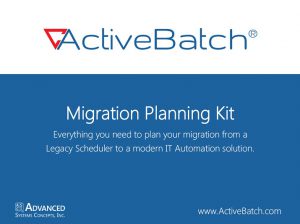Best Practices for Migrating to a New Job Scheduler
Staying with a legacy job scheduler is a big risk. However, following a few fast and true rules will make your job scheduler migration even smoother.

If your job scheduler is making your job more difficult, it might be time to migrate.
Why Migrate to a New Job Scheduler?
Legacy job schedulers are often designed to support specific platforms and systems and can be heavily reliant on scripts. Which means that using a legacy scheduler to support a new technology or application requires researching, writing, and testing complex scripts. Which is time-consuming, error-prone, and the least scalable thing IT can do.
Whether native or home-grown, legacy job schedulers are limited in what they can offer modern, dynamic organizations because they lack the integration capabilities required to quickly build and automate complex workflows.
That’s problematic in an era of rapid digital evolution. IT needs to be able to quickly pivot to support shifting business goals and to leverage new digital tools to stay ahead of competition. This requires building end-to-end workflows that include integrated, automated processes that span a variety of applications, systems, and tools, without the need for custom scripting.
Top motivations for migrating to a new job scheduler:
- Save money on the rising maintenance costs of legacy job schedulers
- Build end-to-end workflows across a variety of platforms
- Reliably and easily build complex workflows with prebuilt integrations
- Add efficiencies to IT by consolidating existing schedulers
- Achieve scalability through dynamic resources and cloud-based or hybrid workflows
- Gain new capabilities like change management, event triggers, SLA monitoring, and more

Get everything you need to help plan your next job scheduler migration.
6 Best Practices for a Successful Job Scheduler Migration
- Automate Your Migration
The best job schedulers include an automated migration tool that helps users keep existing data intact as they move over to a new job scheduler. By using an automated migration tool, IT can minimize the risk of manual errors and of losing critical workflows. Automating can make a migration faster and easier for IT as it does not require as many developer resources. This is especially true for larger or more complex environments: If your team will need to migrate more than a few hundred jobs, an automated migration tool can save a lot of time.
- Use the Cutover method.
The Cutover method for migrating requires moving workflows one-by-one into the new scheduler. As each workflow is migrated, it gets tested, and when it tests successfully the workflow in the old scheduler is disabled until, finally, there is nothing running in the old scheduler. The Cutover method includes the cautious pragmatism of running both schedulers side-by-side over several weeks, while allowing for the velocity and efficiency IT needs to stay ahead of business demands.
- Organize dependencies into groups.
Running a smooth migration starts with a taking an inventory of the workflows, jobs, objects, etc., that are to be migrated. Then, map the dependencies for those workflows and prioritize which items need to be moved, first. The goal is to avoid migrating a workflow that cannot run in the new job scheduler because of missing dependencies. The best way to do this is to place dependencies (and anything else a workflow might need to successfully run, such as alerts, scheduling, or documentation) into a folder which can be migrated with the workflow.
- Spring cleaning.
Schedulers tend to get cluttered, just like your smartphone, laptop, garage, and closet. Fortunately, you’ve just taken an inventory of all the items in your old job scheduler. You know what workflows haven’t been run in 10 years and which objects were created for processes your department no longer needs. Time to start cleaning.Once you have a clean, distilled list of the workflows and items you will be migrating, you’ll have a better understanding of the time commitment needed to complete the migration.
- Optimize workflows.
As you migrate to a new job scheduler, take the opportunity to rebuild workflows. Migrate critical workflows, first, and then rebuild any remaining workflows that are overly complex, unwieldy, and problematic. This is also a great time to establish new policies and best practices that support a more holistic approach to IT Automation.
- Train users on the new job scheduler.
Nothing improves the ROI of a migration faster than training. Users are likely to be unfamiliar with the new job scheduling solution, unsure of how to run jobs, monitor progress, or build workflows. In-depth, role-based training programs help new users become experts sooner by giving them the know-how needed to effectively manage their new systems. This in turn reduces errors, improves ROI, and helps ensure that the migration remains a success in the weeks and months following implementation.
Finally, once your migration is complete, build out new objects and workflows, test and leverage your job scheduler’s capabilities, and keep learning. As technology and business needs continue to evolve, you’ll have access to every job scheduling capability that you can get.
Ready to simplify your data warehousing with workload automation?
Schedule a demo to watch our experts run jobs that match your business requirements in ActiveBatch. Get your questions answered and learn how easy it is to build and maintain your jobs.







